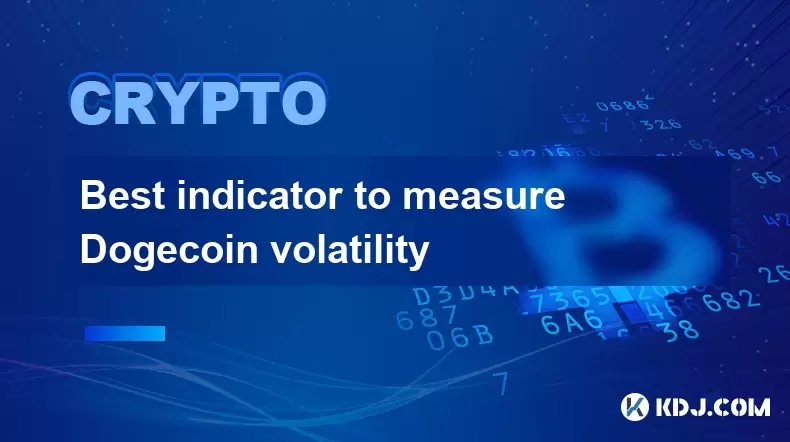-
 bitcoin
bitcoin $115139.818732 USD
-0.61% -
 ethereum
ethereum $4598.676579 USD
-1.26% -
 xrp
xrp $3.029978 USD
-2.08% -
 tether
tether $1.000434 USD
0.01% -
 solana
solana $240.784980 USD
-1.13% -
 bnb
bnb $925.044734 USD
-0.61% -
 usd-coin
usd-coin $0.999772 USD
0.01% -
 dogecoin
dogecoin $0.277157 USD
-2.21% -
 tron
tron $0.348716 USD
-0.26% -
 cardano
cardano $0.885611 USD
-3.31% -
 hyperliquid
hyperliquid $53.547629 USD
-2.46% -
 chainlink
chainlink $24.053828 USD
-2.67% -
 ethena-usde
ethena-usde $1.001251 USD
0.02% -
 sui
sui $3.671154 USD
-2.26% -
 avalanche
avalanche $29.401465 USD
-1.56%
Best indicator to measure Bitcoincoin volatility
Dogecoin's volatility, driven by social media and speculation, can be effectively measured using tools like Bollinger Bands and ATR for informed trading decisions.
Jul 05, 2025 at 07:35 pm

Understanding Dogecoin Volatility
Dogecoin (DOGE), originally created as a meme cryptocurrency, has grown into one of the most actively traded digital assets. Its volatility, however, remains a major concern for investors and traders alike. Unlike traditional financial instruments, cryptocurrencies like Dogecoin are influenced by social media trends, celebrity endorsements, and speculative trading, which can cause rapid price fluctuations. To manage risk effectively, understanding how to measure this volatility becomes essential.
One of the primary reasons Dogecoin exhibits high volatility is its relatively low market capitalization compared to larger cryptocurrencies like Bitcoin or Ethereum. This makes it more susceptible to large price swings based on minor news events or whale movements. Therefore, measuring volatility helps traders assess potential risks and opportunities in real time.
Common Indicators Used to Measure Cryptocurrency Volatility
There are several technical indicators commonly used in crypto markets to gauge volatility:
- Bollinger Bands: These bands plot two standard deviations away from a simple moving average and expand or contract based on recent price action.
- Average True Range (ATR): ATR measures market volatility by decomposing the entire range of an asset price for that period.
- Volatility Index (VIX): Though primarily used in traditional markets, similar models have been adapted for crypto to estimate expected volatility.
- Historical Volatility (HV): This calculates past price fluctuations over a specified time frame to give a sense of how volatile an asset has been historically.
Each of these tools offers unique insights into how volatile Dogecoin might be at any given time. However, their effectiveness varies depending on the trader's strategy and time horizon.
Why Bollinger Bands Are Effective for Measuring DOGE Volatility
Among the various tools available, Bollinger Bands are particularly effective for analyzing Dogecoin volatility due to their dynamic nature. The indicator consists of three lines:
- A middle band, typically a 20-period simple moving average
- An upper band, set two standard deviations above the middle band
- A lower band, set two standard deviations below the middle band
When Dogecoin’s price approaches or breaks through the upper or lower bands, it often signals increased volatility. Moreover, when the bands narrow (a phenomenon known as 'the squeeze'), it indicates decreasing volatility and often precedes sharp price moves.
Traders can use this information to anticipate breakouts or breakdowns in DOGE’s price, especially when combined with volume analysis or other confirming indicators.
Using Average True Range (ATR) to Gauge DOGE’s Price Movement Potential
The Average True Range (ATR) is another powerful tool for assessing Dogecoin volatility. It provides a numerical value representing the average amount an asset moves over a specific period, typically 14 days.
To apply ATR to Dogecoin:
- Set up the ATR indicator on your charting platform with a 14-period setting.
- Observe the ATR values over time; higher values indicate increased volatility, while lower values suggest calm markets.
- Use ATR to adjust stop-loss levels or determine position sizes based on current volatility conditions.
For instance, if Dogecoin’s ATR is showing a sudden spike, it may signal a breakout or significant market event. Traders can then prepare for larger-than-normal price swings and adjust their strategies accordingly.
This adaptability makes ATR a reliable companion for both short-term traders and long-term investors who want to stay informed about market turbulence affecting DOGE.
Combining Multiple Indicators for Accurate Volatility Assessment
While individual indicators like Bollinger Bands or ATR offer valuable insights, combining them enhances accuracy in measuring Dogecoin volatility.
Here’s how you can integrate multiple tools:
- Overlay Bollinger Bands with ATR to confirm volatility expansion or contraction phases.
- Add volume indicators such as On-Balance Volume (OBV) or Volume Weighted Average Price (VWAP) to validate whether price moves are supported by strong trading activity.
- Use moving averages alongside Bollinger Bands to identify trend direction and filter out false volatility signals.
By cross-referencing these tools, traders gain a more comprehensive view of Dogecoin’s volatility, allowing for better-informed decisions during both calm and turbulent market conditions.
Practical Steps to Apply Volatility Indicators on Trading Platforms
To implement these volatility-measuring techniques practically, follow these steps using platforms like TradingView or Binance:
- Log in to your preferred trading platform and navigate to the Dogecoin chart.
- Access the indicators menu and add Bollinger Bands with default settings (20-period SMA and 2 standard deviations).
- Add the ATR indicator with a 14-period setting beneath the price chart.
- Optionally, include volume-based indicators for confirmation.
- Customize colors and line thickness for clarity, especially when overlapping occurs.
- Save this setup as a template for future reference.
Once applied, monitor how Dogecoin’s price interacts with these indicators in real-time. Adjust parameters if necessary to suit your trading style, but avoid overcomplicating the chart with too many overlapping tools.
Frequently Asked Questions
Q: Can I use volatility indicators for Dogecoin on mobile apps?Yes, most modern trading apps like Binance, CoinMarketCap, and TradingView Mobile support volatility indicators including Bollinger Bands and ATR.
Q: How often should I update my volatility measurement settings for Dogecoin?You don’t need to change settings frequently unless you’re switching between intraday and swing trading. Default settings work well for most scenarios involving DOGE.
Q: Do volatility indicators predict price direction?No, volatility indicators only reflect the magnitude of price movement, not the direction. They should be used in conjunction with directional indicators like MACD or RSI.
Q: Is there a single best volatility indicator for Dogecoin?There isn't a universally best indicator. Bollinger Bands and ATR are widely used, but the choice depends on your trading strategy and personal preference.
Disclaimer:info@kdj.com
The information provided is not trading advice. kdj.com does not assume any responsibility for any investments made based on the information provided in this article. Cryptocurrencies are highly volatile and it is highly recommended that you invest with caution after thorough research!
If you believe that the content used on this website infringes your copyright, please contact us immediately (info@kdj.com) and we will delete it promptly.
- Dogecoin in 2025: Poised for a Profitable Month?
- 2025-09-15 08:50:01
- Altcoins on Fire: Solana, SUI, DOT, and the Rise of Layer Brett
- 2025-09-15 08:50:01
- Polkadot's App-Building Revolution: JAM, DevContainers, and the DOT Token's Future
- 2025-09-15 08:25:14
- Dogecoin, Solana, Crypto Assets: Riding the Wave of Momentum and Madness
- 2025-09-15 08:50:01
- XRP's Market Value Skyrockets: Price Surge on the Horizon?
- 2025-09-15 09:00:01
- Bitcoin Cash, Ethereum Classic, and Presales: What's the Buzz in September 2025?
- 2025-09-15 09:00:01
Related knowledge

Bitcoincoin burning mechanism
Jul 20,2025 at 09:21pm
What is the Dogecoin burning mechanism?The Dogecoin burning mechanism refers to the process of permanently removing DOGE tokens from circulation by se...

How to earn free Bitcoincoin?
Jul 19,2025 at 10:08pm
What is Dogecoin and Why Earn It?Dogecoin (DOGE) started as a meme-based cryptocurrency in 2013 but has grown into a widely recognized digital asset. ...

Is Coinbase a good wallet for Bitcoincoin?
Jul 19,2025 at 04:42pm
Understanding Coinbase as a Wallet Option for DogecoinWhen considering where to store Dogecoin, Coinbase is often mentioned as a potential option due ...

How to buy Bitcoincoin with PayPal?
Jul 23,2025 at 06:57am
Understanding the Basics of Buying DogecoinBefore diving into the process of buying Dogecoin with PayPal, it’s essential to understand what Dogecoin i...

Best app to buy Dogecoin
Jul 23,2025 at 03:08pm
What Is a Cryptocurrency Exchange and How Does It Work?A cryptocurrency exchange is a digital marketplace where users can buy, sell, or trade cryptocu...

How are Dogecoin gains taxed?
Jul 25,2025 at 07:01am
Understanding the Taxation of Dogecoin GainsWhen it comes to Dogecoin (DOGE), many investors are drawn to its meme-inspired branding and volatile pric...

Bitcoincoin burning mechanism
Jul 20,2025 at 09:21pm
What is the Dogecoin burning mechanism?The Dogecoin burning mechanism refers to the process of permanently removing DOGE tokens from circulation by se...

How to earn free Bitcoincoin?
Jul 19,2025 at 10:08pm
What is Dogecoin and Why Earn It?Dogecoin (DOGE) started as a meme-based cryptocurrency in 2013 but has grown into a widely recognized digital asset. ...

Is Coinbase a good wallet for Bitcoincoin?
Jul 19,2025 at 04:42pm
Understanding Coinbase as a Wallet Option for DogecoinWhen considering where to store Dogecoin, Coinbase is often mentioned as a potential option due ...

How to buy Bitcoincoin with PayPal?
Jul 23,2025 at 06:57am
Understanding the Basics of Buying DogecoinBefore diving into the process of buying Dogecoin with PayPal, it’s essential to understand what Dogecoin i...

Best app to buy Dogecoin
Jul 23,2025 at 03:08pm
What Is a Cryptocurrency Exchange and How Does It Work?A cryptocurrency exchange is a digital marketplace where users can buy, sell, or trade cryptocu...

How are Dogecoin gains taxed?
Jul 25,2025 at 07:01am
Understanding the Taxation of Dogecoin GainsWhen it comes to Dogecoin (DOGE), many investors are drawn to its meme-inspired branding and volatile pric...
See all articles





















![Trump WLFI token private key collision project, can use multiple windows and claim to be a single window income of four digits [Protocol script + usage tutorial] #Make money at home#Make money at side business Trump WLFI token private key collision project, can use multiple windows and claim to be a single window income of four digits [Protocol script + usage tutorial] #Make money at home#Make money at side business](/uploads/2025/09/15/cryptocurrencies-news/videos/trump-wlfi-token-private-key-collision-project-multiple-windows-claim-single-window-income-digits-protocol-script-usage-tutorial-money-money-business/68c76555f1557_image_500_375.webp)




















































